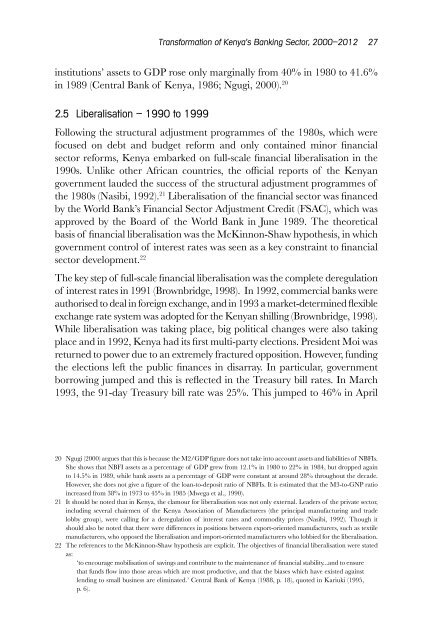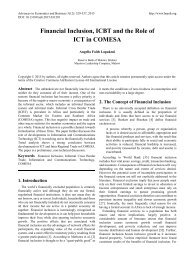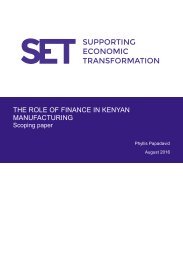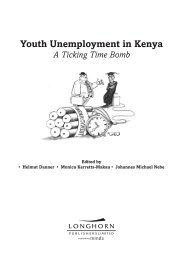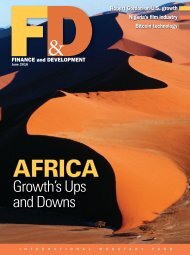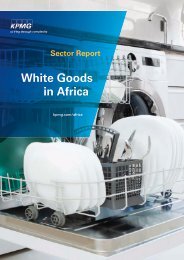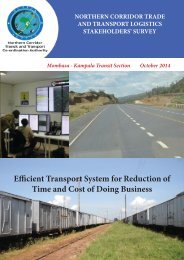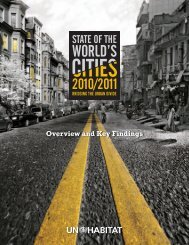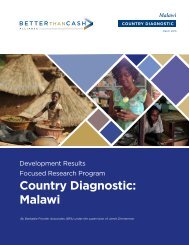in the 21st Century
hTOE305aYVW
hTOE305aYVW
Create successful ePaper yourself
Turn your PDF publications into a flip-book with our unique Google optimized e-Paper software.
Transformation of Kenya’s Bank<strong>in</strong>g Sector, 2000–2012 27<br />
<strong>in</strong>stitutions’ assets to GDP rose only marg<strong>in</strong>ally from 40% <strong>in</strong> 1980 to 41.6%<br />
<strong>in</strong> 1989 (Central Bank of Kenya, 1986; Ngugi, 2000). 20<br />
2.5 Liberalisation – 1990 to 1999<br />
Follow<strong>in</strong>g <strong>the</strong> structural adjustment programmes of <strong>the</strong> 1980s, which were<br />
focused on debt and budget reform and only conta<strong>in</strong>ed m<strong>in</strong>or f<strong>in</strong>ancial<br />
sector reforms, Kenya embarked on full-scale f<strong>in</strong>ancial liberalisation <strong>in</strong> <strong>the</strong><br />
1990s. Unlike o<strong>the</strong>r African countries, <strong>the</strong> official reports of <strong>the</strong> Kenyan<br />
government lauded <strong>the</strong> success of <strong>the</strong> structural adjustment programmes of<br />
<strong>the</strong> 1980s (Nasibi, 1992). 21 Liberalisation of <strong>the</strong> f<strong>in</strong>ancial sector was f<strong>in</strong>anced<br />
by <strong>the</strong> World Bank’s F<strong>in</strong>ancial Sector Adjustment Credit (FSAC), which was<br />
approved by <strong>the</strong> Board of <strong>the</strong> World Bank <strong>in</strong> June 1989. The <strong>the</strong>oretical<br />
basis of f<strong>in</strong>ancial liberalisation was <strong>the</strong> McK<strong>in</strong>non-Shaw hypo<strong>the</strong>sis, <strong>in</strong> which<br />
government control of <strong>in</strong>terest rates was seen as a key constra<strong>in</strong>t to f<strong>in</strong>ancial<br />
sector development. 22<br />
The key step of full-scale f<strong>in</strong>ancial liberalisation was <strong>the</strong> complete deregulation<br />
of <strong>in</strong>terest rates <strong>in</strong> 1991 (Brownbridge, 1998). In 1992, commercial banks were<br />
authorised to deal <strong>in</strong> foreign exchange, and <strong>in</strong> 1993 a market-determ<strong>in</strong>ed flexible<br />
exchange rate system was adopted for <strong>the</strong> Kenyan shill<strong>in</strong>g (Brownbridge, 1998).<br />
While liberalisation was tak<strong>in</strong>g place, big political changes were also tak<strong>in</strong>g<br />
place and <strong>in</strong> 1992, Kenya had its first multi-party elections. President Moi was<br />
returned to power due to an extremely fractured opposition. However, fund<strong>in</strong>g<br />
<strong>the</strong> elections left <strong>the</strong> public f<strong>in</strong>ances <strong>in</strong> disarray. In particular, government<br />
borrow<strong>in</strong>g jumped and this is reflected <strong>in</strong> <strong>the</strong> Treasury bill rates. In March<br />
1993, <strong>the</strong> 91-day Treasury bill rate was 25%. This jumped to 46% <strong>in</strong> April<br />
20 Ngugi (2000) argues that this is because <strong>the</strong> M2/GDP figure does not take <strong>in</strong>to account assets and liabilities of NBFIs.<br />
She shows that NBFI assets as a percentage of GDP grew from 12.1% <strong>in</strong> 1980 to 22% <strong>in</strong> 1984, but dropped aga<strong>in</strong><br />
to 14.5% <strong>in</strong> 1989, while bank assets as a percentage of GDP were constant at around 28% throughout <strong>the</strong> decade.<br />
However, she does not give a figure of <strong>the</strong> loan-to-deposit ratio of NBFIs. It is estimated that <strong>the</strong> M3-to-GNP ratio<br />
<strong>in</strong>creased from 38% <strong>in</strong> 1973 to 45% <strong>in</strong> 1985 (Mwega et al., 1990).<br />
21 It should be noted that <strong>in</strong> Kenya, <strong>the</strong> clamour for liberalisation was not only external. Leaders of <strong>the</strong> private sector,<br />
<strong>in</strong>clud<strong>in</strong>g several chairmen of <strong>the</strong> Kenya Association of Manufacturers (<strong>the</strong> pr<strong>in</strong>cipal manufactur<strong>in</strong>g and trade<br />
lobby group), were call<strong>in</strong>g for a deregulation of <strong>in</strong>terest rates and commodity prices (Nasibi, 1992). Though it<br />
should also be noted that <strong>the</strong>re were differences <strong>in</strong> positions between export-oriented manufacturers, such as textile<br />
manufacturers, who opposed <strong>the</strong> liberalisation and import-oriented manufacturers who lobbied for <strong>the</strong> liberalisation.<br />
22 The references to <strong>the</strong> McK<strong>in</strong>non-Shaw hypo<strong>the</strong>sis are explicit. The objectives of f<strong>in</strong>ancial liberalisation were stated<br />
as:<br />
‘to encourage mobilisation of sav<strong>in</strong>gs and contribute to <strong>the</strong> ma<strong>in</strong>tenance of f<strong>in</strong>ancial stability...and to ensure<br />
that funds flow <strong>in</strong>to those areas which are most productive, and that <strong>the</strong> biases which have existed aga<strong>in</strong>st<br />
lend<strong>in</strong>g to small bus<strong>in</strong>ess are elim<strong>in</strong>ated.’ Central Bank of Kenya (1988, p. 18), quoted <strong>in</strong> Kariuki (1995,<br />
p. 6).


